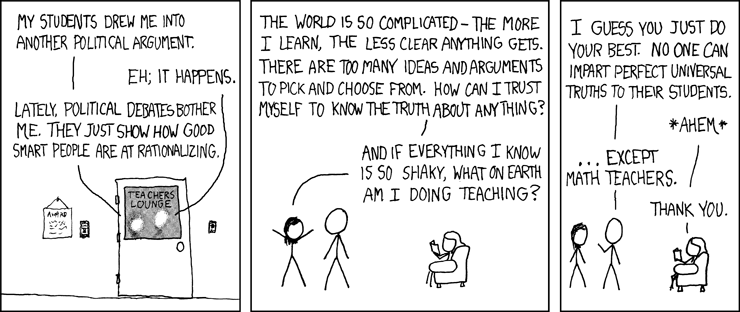Sanity Through Math
This has been a tumultuous three months. I have been overwhelmed, frightened, angry, excited.
The world has been horrible. My employer has been heartless. My union has been too often passive. My friends are distant.
And my work has been exhausting. The grading – absurdly slow. Lessons? Maybe I’ve figured something reasonable out. I’m not certain, not about that. It’s taken me twelve weeks.
But math can be centering. Almost twenty years ago I registered for a too-hard-for-me math class at the Graduate Center (and one not-too-hard-for-me which I loved). This was the fall of 2001, and events in New York City interrupted class for a few weeks. Then we came back, and at the first session, Roman Kossak, the professor, said a few words about what had happened and then “sometimes when the world is falling apart around us, the best thing to do is some math.” Maybe he was right.
This morning I shared some enrichment work (mostly for my juniors, but optional for my seniors) and I included this cartoon (xkcd, by Randall Munroe):
Certainty

Now, if you hover your mouse over it, you’ll get a bonus, some alt-text: I didn’t share all of it with my students.
But I do think there is something comforting about considering problems with right and wrong answers.
And at 1PM today I finished my mini-elective in Axiomatic Arithmetic. Super-hard work. One lunch-time session per week, for 17 or 18 weeks, we studied arithmetic. We learned some history about the push to axiomatize systems other than geometry. We relearned arithmetic (I channeled my professor, David Rothschild, as we learned to count, add, subtract, multiply, divide, including after the “point” using the symbols /, ∆, ☐, O as the four symbols for base four.) I taught them standard high-school level mathematical induction. And then we read 10 pages of this text I found on-line: http://www.fen.bilkent.edu.tr/~franz/lect/ncp.pdf.
Now, you may say, 10 pages? The heart of a course was 10 pages? Well yes. And the pages are small. It was 1/4 of a credit, maybe it should have been worth more. We read pretty much every word. We discussed almost every word. They submitted proofs. Strong induction. Slowly we developed a little bit of a comfort level. We proved everything. When we finally got to proving addition was commutative – wow! Can you imagine defining multiplication? Proving distribution works? (twice, once from the left, once from the right. There you go, Randall Munroe).
And today? The hardest proof of the course. We spent almost an hour of an extended session. (Feel free to skip ahead)
Theorem 1.21. Every nonempty subset S ∈ N has a smallest element.
Proof. Let S ⊆ N be non-empty, and define R = {x ∈ N : x ≤ y for all y ∈ S}.
Then 0 ∈ R since 0 ≤ y for all y ∈ N, in particular for all y ∈ S.
Since S is non-empty, there is a y ∈ S; this implies y + 1 ∉ R: otherwise we would have y + 1 ≤ y, which does not hold (we have y ≤ y + 1 by (1.7), so y + 1 ≤ y would imply y + 1 = y, hence 1 = 0 and s(0) = 0 in contradiction with N3).
Thus R contains 0 but R ≠ N; the induction axiom then implies that there must exist an x ∈ R such that x + 1 = s(x) ∉ R. We claim that x is a smallest element of S.
First, x ∈ R implies x ≤ y for all y ∈ S, so we only need to show that x ∈ S. Assume x ∉ S; then x ≤ y for all y ∈ S implies x < y (because we can’t have equality), hence x+ 1 = s(x) ≤ y for all y ∈ S, which by definition of R shows that x + 1 ∈ R in contradiction to the construction of x.
All 10 students understood some of this by the end. Most understood most of it. Some of the 10 understood all of it. In a crazy, crazy world, we had done something sane, correct, and difficult. As a teacher, I usually consider the greatest accomplishment to be getting someone who knows very little to learn a tiny bit more. That is super hard. I usually don’t count teaching bright kids as particularly challenging – although it can contain challenges. But this, this course, today’s work, breaks my rule. It felt like an accomplishment.
They are mostly seniors, and I kept them after, to say how much they – and the course – have meant to me. They were my students freshman year, and they did Algebra II (a full year in one term) with me. Some did other electives. I had a lot to say. And now, during the pandemic, we focused on deeply challenging math, week after week. I think they learned a lot. And this class in particular gave me some balance.
And so, for four years’ association, and for being part of a class that was important to me, I wanted to send them on their way with some words of wisdom, but wasn’t prepared, and the words wouldn’t come. Maybe we should have just done one more proof. It would have been easier than saying goodbye.
